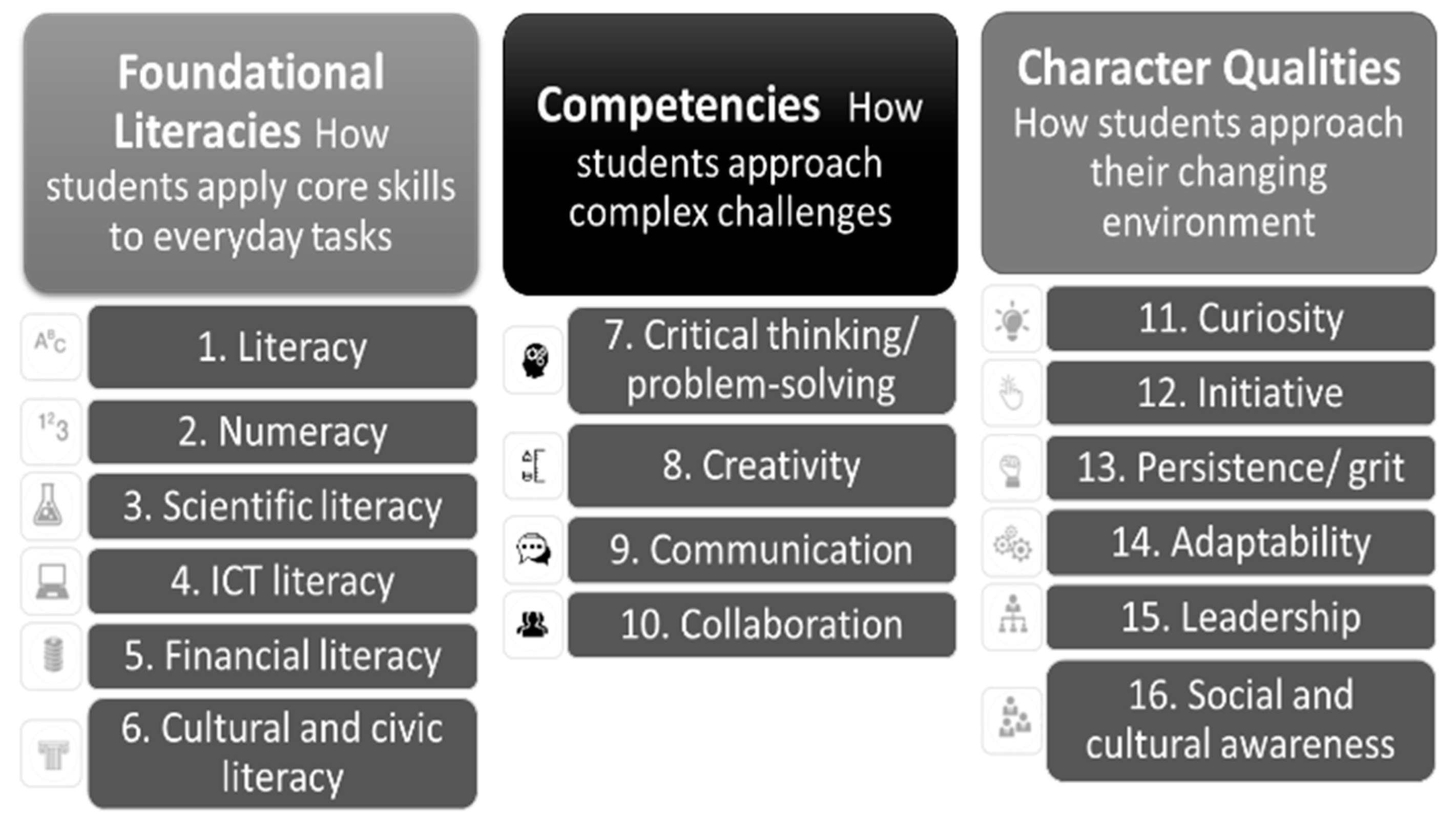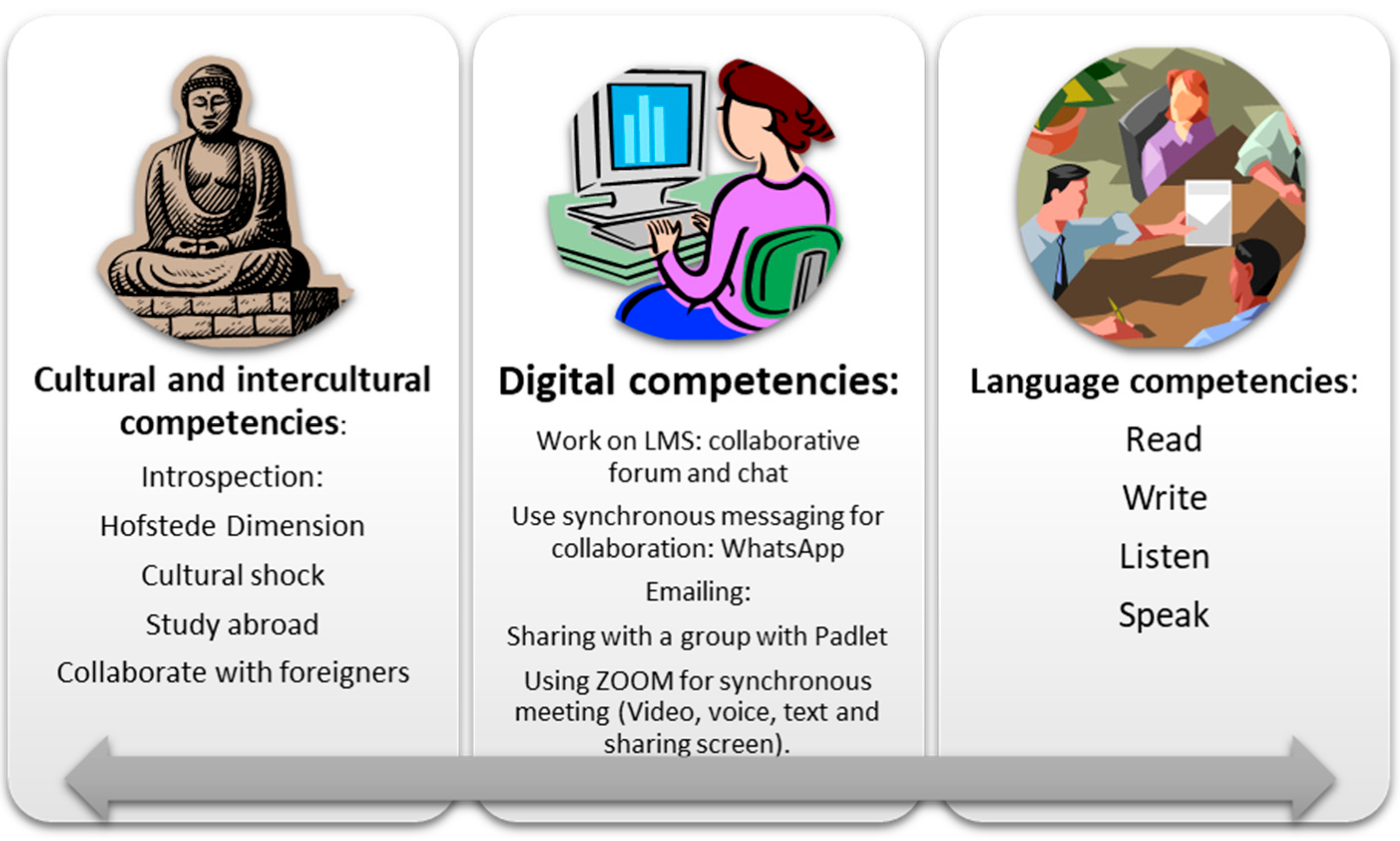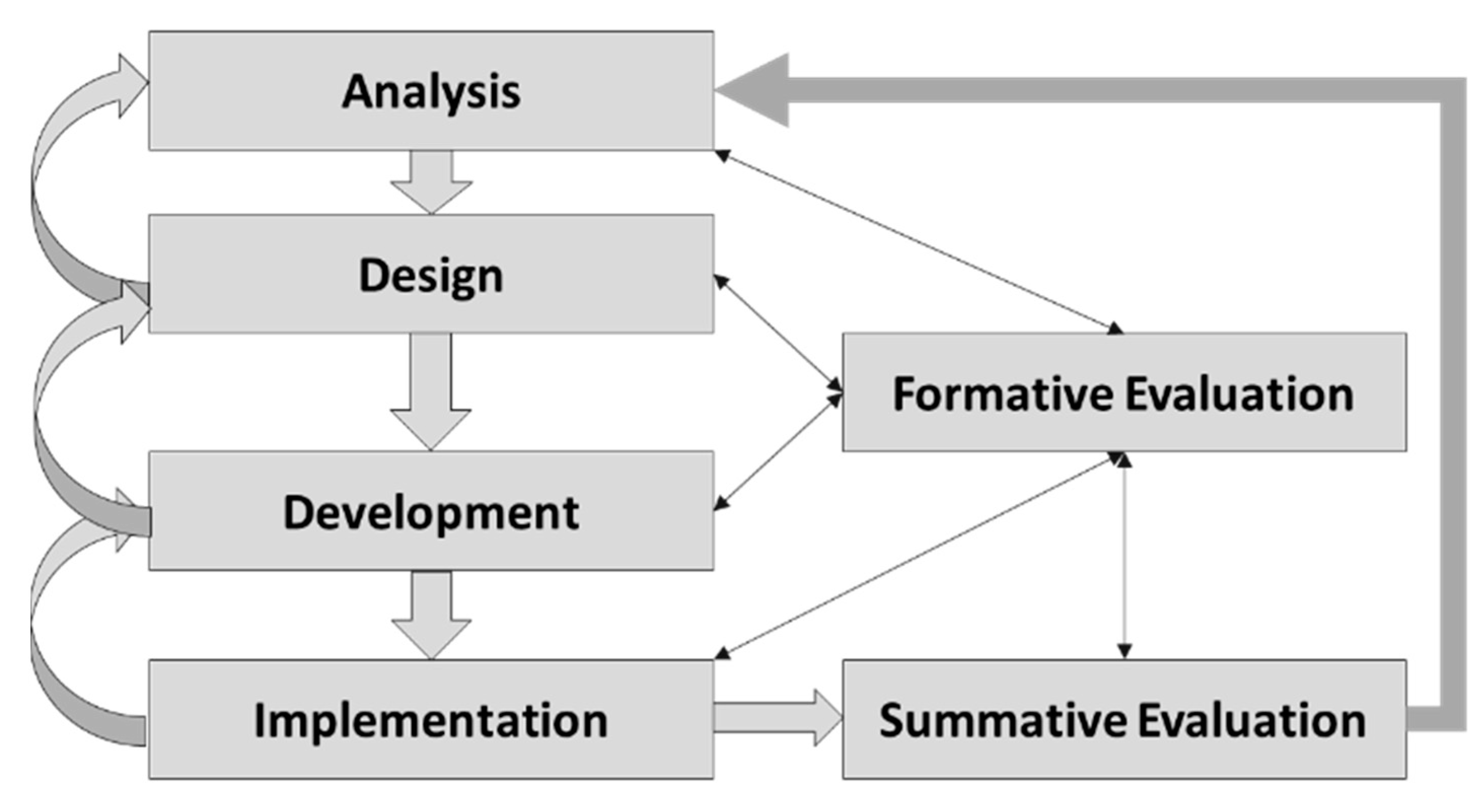Virtual Exchange to Develop Cultural, Language, and Digital Competencies
Abstract
1. Introduction
Global competence is the capacity to analyse global and intercultural issues critically and from multiple perspectives, to understand how differences affect perceptions, judgments, and ideas of self and others, and to engage in open, appropriate, and effective interactions with others from different backgrounds on the basis of a shared respect for human dignity.
2. Erasmus+ Virtual Exchange
- People-to-people interaction and dialogue.
- The learning goals include soft skills such as the development of intercultural awareness, digital literacy, group work, communication, language competency, etc.
- Participants will be seeking mutual understanding and co-creating knowledge, based on their own experiences.
- VE programs explicitly address intercultural understanding and engaging with difference.
3. Theoretical Background
4. The Virtual Exchange Design
4.1. Course Description
4.2. The Pedagogical Design Based on ADDIE and the Five-Stage Framework
“In summary, the five-stage model provides an example of how participants can benefit from increasing skill and comfort in working, networking, and learning online, and what e-moderators need to do at each stage to help them to achieve this success. The model shows how to motivate online participants, to build learning through appropriate e-tivities, and to pace e-learners through programmes of training and development. Individual access and the induction of participants into online learning are essential prerequisites for online conference participation (stage 1, at the base of the flights of steps). Stage 2 involves individual participants establishing their online identities and then finding others with whom to interact. At stage 3, participants engage in mutual exchange of information. Up to and including stage 3, a form of co-operation occurs whereby each person supports the other participants’ goals. At stage 4, course-related group discussions develop and the interaction becomes more collaborative. At stage 5, participants look for more benefits from the system to help them achieve personal goals and reflect on the learning processes.”([53], p. 11)
4.2.1. Analysis
4.2.2. Design
- Students will be able to define and evaluate core elements/perspectives of intercultural communication/interaction in an international exchange,
- They will be able to communicate and collaborate effectively in diverse cultural environments (working with others from different countries), and
- They will be able to use a variety of technological tools to communicate and complete tasks in the VE.
4.2.3. Development
4.2.4. Implementation
4.2.5. Evaluation (Assessment)
5. Research Methodology
6. Results and Discussions
6.1. Language Competencies
“My mind is not so fast with English words (.), I experience that my mind is practicing and now I begin to save words.”(Darina)
“The course was very interesting (.) and we develop our way of communicating.”(Rihab)
Tjasa: Thank you everyone! It was a pleasure to meet you 😊
Kenza: It was amazing to talk with u all guys
Darina: 😄😄😄👏🏼
Darina: It was funny to hear the voices
6.2. Digital Competencies
- 10/10 students accessed the platform, used Padlet, and participated in Zoom sessions at least two times.
- 10/10 students exchanged emails and produced documents.
- 9/10 students used Padlet, shared texts and images, and commented to others.
- 9/10 students participated actively by completing major activities on Moodle.
- 10/10 students participated in the WhatsApp group, asking questions or responding to others.
“I figured out how to use Zoom on my own, which is a nice experience.”(Andre)
“Tools like Padlet and Zoom have many benefits.”(Kenza)
6.3. Cultural and Intercultural Competencies
6.3.1. Differences between Small and Large Power Distance Societies
6.3.2. Differences between Weak and Strong Uncertainty Avoidance Societies
6.3.3. Differences between Collectivist and Individualist Societies
6.3.4. Differences between Feminine and Masculine Societies
6.3.5. Differences between Short- and Long-Term-Oriented Societies
6.3.6. Differences between Indulgent and Restrained Societies
7. Conclusions and Perspectives
- Some improvement in students’ oral and written English language skills.
- Students’ mastery of new digital tools for sharing, collaboration, and communicating.
- A clear awareness of the cultural parameters of the Hofstede model, starting from personal introspection to the perception of the clash of cultures with the projection of living in a culturally distant society.
Author Contributions
Funding
Institutional Review Board Statement
Informed Consent Statement
Data Availability Statement
Acknowledgments
Conflicts of Interest
References
- Pécoud, A.; de Guchteneire, P.; Guchteneire, P.F.A. Migration without Borders: Essays on the Free Movement of People; Berghahn Books: New York, NY, USA, 2007; ISBN 978-1-84545-360-2. [Google Scholar]
- Czaika, M.; Orazbayev, S. The Globalisation of Scientific Mobility, 1970–2014. Appl. Geogr. 2018, 96, 1–10. [Google Scholar] [CrossRef]
- Suarez-Orozco, M. Learning in the Global Era: International Perspectives on Globalization and Education; University of California Press: Oakland, CA, USA, 2007. [Google Scholar]
- Landis, D.; Albert, R.D. (Eds.) Handbook of Ethnic Conflict; International and Cultural Psychology; Springer: Boston, MA, USA, 2012; ISBN 978-1-4614-0447-7. [Google Scholar]
- Department of Economic and Social Affairs. Transforming Our World: The 2030 Agenda for Sustainable Development. Available online: https://sdgs.un.org/2030agenda (accessed on 13 April 2021).
- World Economic Forum New Vision for Education. Unlocking the Potential of Technology. Available online: http://www3.weforum.org/docs/WEFUSA_NewVisionforEducation_Report2015.pdf (accessed on 22 May 2020).
- Xu, X.J.; Li, Y. Building Cross-Cultural Competence Model for Expatriate Managers in Low-to-Middle Levels. In Proceedings of the 2012 International Symposium on Management of Technology (ISMOT), Hangzhou, China, 8 November 2012; pp. 522–526. [Google Scholar]
- Ayers, J. Competence Literate but Context Lacking? Investigating the Potential of Study Abroad Programs to Promote Sustainability Competence Acquisition in Students. Sustainability 2020, 12, 5389. [Google Scholar] [CrossRef]
- Çiftçi, E.Y.; Savaş, P. The Role of Telecollaboration in Language and Intercultural Learning: A Synthesis of Studies Published between 2010 and 2015. ReCALL 2018, 30, 278–298. [Google Scholar] [CrossRef]
- Friedrichs, J. An Intercultural Theory of International Relations: How Self-Worth Underlies Politics among Nations. Int. Theory 2016, 8, 63–96. [Google Scholar] [CrossRef]
- Oren, A.; Mioduser, D.; Nachmia, R. The Development of Social Climate in Virtual Learning Discussion Groups. Int. Rev. Res. Open Distance Learn. 2002, 3. [Google Scholar] [CrossRef]
- Rychen, D.S.; Salganik, L.H. Definition and Selection of Competencies (DESECO): Theoretical and Conceptual Foundations; Swiss Federal Statistical Office: Neuchatel, Switzerland, 2002. [Google Scholar]
- Ramos, G.; Schleicher, A. Global Competency for an Inclusive World; OECD: Paris, France, 2016. [Google Scholar]
- OECD. PISA 2018 Results (Volume VI): Are Students Ready to Thrive in an Interconnected World? OECD: Pisa, Italy, 2020; ISBN 978-92-64-27174-6. [Google Scholar]
- O’Dowd, R. From Telecollaboration to Virtual Exchange: State-of-the-Art and the Role of UNICollaboration in Moving Forward. J. Virtual Exch. 2018, 1, 1–23. [Google Scholar] [CrossRef]
- Vinagre, M. Developing Teachers’ Telecollaborative Competences in Online Experiential Learning. System 2017, 64, 34–45. [Google Scholar] [CrossRef]
- European Union. EACEA Debate Exchange Team Leader Manual. Available online: https://europa.eu/youth/sites/default/files/eyp/eve/attachments/en._debate_exchange_-_team_leaders_manual_-_april_2019.pdf (accessed on 1 January 2020).
- Morgan, T.; Carey, S. From Open Content to Open Course Models: Increasing Access and Enabling Global Participation in Higher Education. Int. Rev. Res. Open Distance Learn. 2009, 10. [Google Scholar] [CrossRef]
- O’Dowd, R. Telecollaborative Networks in University Higher Education: Overcoming Barriers to Integration. Internet High. Educ. 2013, 18, 47–53. [Google Scholar] [CrossRef]
- About Erasmus+ Virtual Exchange. Available online: https://europa.eu/youth/node/54451_en (accessed on 1 September 2019).
- About Virtual Exchange. Available online: https://europa.eu/youth/erasmusvirtual/about-virtual-exchange_en (accessed on 1 September 2019).
- Global Flow of Tertiary-Level Students. Available online: http://uis.unesco.org/en/uis-student-flow (accessed on 14 March 2021).
- European Commission. The European Higher Education Area in 2018: Bologna Process Implementation Report; European Commission: Brussels, Belgium, 2018; ISBN 978-92-9492-739-2. [Google Scholar]
- Ballatore, M.; Ferede, M.K. The Erasmus Programme in France, Italy and the United Kingdom: Student Mobility as a Signal of Distinction and Privilege. Eur. Educ. Res. J. 2013, 12, 525–533. [Google Scholar] [CrossRef]
- Rapport d’activités 2018, Résultats Erasmus+ 2014–2018. Available online: http://www.agence-erasmus.fr/docs/2773_ra-2018.pdf (accessed on 1 September 2019).
- Enarson, H.; Drucker, P.F. Innovation in Higher Education. J. High. Educ. 2021, 31, 495–501. [Google Scholar] [CrossRef]
- Tierney, W.G.; Lanford, M. Conceptualizing Innovation in Higher Education. In Higher Education: Handbook of Theory and Research; Paulsen, M.B., Ed.; Springer: Cham, Switzerland, 2016; Volume 31, pp. 1–40. ISBN 978-3-319-26828-6. [Google Scholar]
- Cabedo, L.; Royo, M.; Moliner, L.; Guraya, T. University Social Responsibility towards Engineering Undergraduates: The Effect of Methodology on a Service-Learning Experience. Sustainability 2018, 10, 1823. [Google Scholar] [CrossRef]
- Thomas, I. Special Issue—Pedagogy for Education for Sustainability in Higher Education. Sustainability 2014, 6, 1705–1708. [Google Scholar] [CrossRef]
- O’Dowd, R. Emerging Trends and New Directions in Telecollaborative Learning. CALICO J. 2016, 33, 291–310. [Google Scholar] [CrossRef]
- Louhiala-Salminen, L.; Kankaanranta, A. Professional Communication in a Global Business Context: The Notion of Global Communicative Competence. IEEE Trans. Profess. Commun. 2011, 54, 244–262. [Google Scholar] [CrossRef]
- Byram, M. Conceptualizing Intercultural (Communicative) Competence and Intercultural Citizenship. In The Routledge Handbook of Language and Intercultural Communication; Routledge: Abingdon, UK, 2012; pp. 85–97. [Google Scholar]
- Byram, M.; Zarate, G. Defining and Assessing Intercultural Competence: Some Principles and Proposals for the European Context. Lang. Teach. 1996, 29, 239–243. [Google Scholar] [CrossRef]
- Ai, B.; Cui, C.; Wang, L. Language, Identity, and Transnational Communication: Chinese Business Expatriates in Africa. IEEE Trans. Profess. Commun. 2019, 62, 178–191. [Google Scholar] [CrossRef]
- Lai, J.; Shen, T.; Hsieh, M. The Analysis of the Relationship between Cultural Factor and Second Language Acquisition. In Proceedings of the 2016 International Conference on Advanced Materials for Science and Engineering (ICAMSE), Tainan, Taiwan, 12–13 November 2016; pp. 412–415. [Google Scholar]
- Nascimbeni, F.; Burgos, D.; Aceto, S.; Wimpenny, K.; Maya, I.; Stefanelli, C.; Eldeib, A. Exploring Intercultural Learning through a Blended Course about Open Education Practices across the Mediterranean. In Proceedings of the 2018 IEEE Global Engineering Education Conference (EDUCON), Tenerife, Spain, 17–20 April 2018; pp. 285–288. [Google Scholar]
- Zumbihl, H. Cadre théorique et méthodologique d’une étude sur l’acquisition de la compétence de médiation culturelle en milieu universitaire. ASP 2004, 125–134. [Google Scholar] [CrossRef]
- Tu, J.-C.; Zhang, X.-Y.; Chiu, S.-P. Assessing the Impact of Cultural Intelligence on Sustainable Career Competitive Advantage for Students in College of Design. Sustainability 2020, 12, 10. [Google Scholar] [CrossRef]
- Jager, S.; Meima, E.; Oggel, G. Oral Proficiency Teaching with WebCEF and Skype: Scenarios for Online Production and Interaction Tasks. Lang. Learn. High. Educ. 2013, 2. [Google Scholar] [CrossRef]
- Lee, L. Promoting Intercultural Exchanges with Blogs and Podcasting: A Study of Spanish–American Telecollaboration. Comput. Assist. Lang. Learn. 2009, 22, 425–443. [Google Scholar] [CrossRef]
- García-Sánchez, S.; Rojas-Lizana, S. Bridging the Language and Cultural Gaps: The Use of Blogs. Technol. Pedagog. Educ. 2012, 21, 361–381. [Google Scholar] [CrossRef]
- Knight, S. Effective Practice in a Digital Age. Available online: http://repository.jisc.ac.uk/6004/1/effectivepracticedigitalage.pdf (accessed on 1 September 2019).
- Fuchs, C. “Are You Able to Access This Website at All?”—Team Negotiations and Macro-Level Challenges in Telecollaboration. Comput. Assist. Lang. Learn. 2016, 29, 1152–1168. [Google Scholar] [CrossRef]
- Barth, M.; Burandt, S. Adding the “e-” to Learning for Sustainable Development: Challenges and Innovation. Sustainability 2013, 5, 2609–2622. [Google Scholar] [CrossRef]
- Peiser, G. Overcoming Barriers: Engaging Younger Students in an Online Intercultural Exchange. Intercult. Educ. 2015, 26, 361–376. [Google Scholar] [CrossRef]
- Hauck, M.; Müller-Hartmann, A.; Rienties, B.; Rogaten, J. Approaches to Researching Digital-Pedagogical Competence Development in VE-Based Teacher Education. J. Virtual Exch. 2020, 3, 5–35. [Google Scholar] [CrossRef]
- Salomão, A.C.B.; Viana da Silva, E. The Application of the Global Competence Matrix in a Virtual Exchange Program with US and Brazilian Students. J. Virtual Exch. 2020, 3, 1–12. [Google Scholar] [CrossRef]
- Ferreira-Lopes, L.; Bezanilla, M.J.; Elexpuru, I. Integrating Intercultural Competence Development into the Curriculum through Telecollaboration. A Task Sequence Proposal for Higher Education. Rev. Edu. Distancia 2018. [Google Scholar] [CrossRef]
- Leeds-Hurwitz, W. Intercultural Competences: Conceptual and Operational Framework. 2013. Available online: https://unesdoc.unesco.org/ark:/48223/pf0000219768 (accessed on 1 September 2020).
- Klieme, E.; Hartig, J.; Rauch, D. The Concept of Competence in Educational Contexts. Assess. Competencies Educ. Contexts 2008, 3, 22. [Google Scholar]
- Le Deist, F.D.; Winterton, J. What Is Competence? Hum. Resour. Dev. Int. 2005, 8, 27–46. [Google Scholar] [CrossRef]
- Braxton, S.; Bronico, K.; Looms, T. Instructional System Design (ISD): Using the ADDIE Model; George Washington University: Washington, DC, USA, 2000. [Google Scholar]
- Salmon, G. E-Tivities: The Key to Active Online Learning; Routledge: Abingdon, UK, 2013. [Google Scholar]
- Karsenti, T.; Savoie-Zajc, L. La Recherche en Éducation, Etapes et Approches? 4th ed.; Les Presses de l’Université de Montréal: Montreal, QC, Canada, 2018; ISBN 978-2-7606-3933-1. [Google Scholar]
- Mulhall, A. In the field: Notes on observation in qualitative research. J. Adv. Nurs. 2003, 41, 306–313. [Google Scholar] [CrossRef] [PubMed]
- Avgousti, M.I. Intercultural communicative competence and online exchanges: A systematic review. Comput. Assist. Lang. Learn. 2018, 31, 819–853. [Google Scholar] [CrossRef]
- Korzh, R.; Peleschyshyn, A.; Syerov, Y.; Fedushko, S. The Cataloging of Virtual Communities of Educational Thematic. Webology 2014, 11, 16. [Google Scholar]
- Bueno-Alastuey, M.C.; Kleban, M. Matching Linguistic and Pedagogical Objectives in a Telecollaboration Project: A Case Study. Comput. Assist. Lang. Learn. 2016, 29, 148–166. [Google Scholar] [CrossRef]
- Kleban, M.; Bueno-Alastuey, M.C. Creating Pedagogical Knowledge through Electronic Materials in a Telecollaboration Project for Pre-Service Teacher Trainees. In WorldCALL: Sustainability and Computer-Assisted Language Learning; Gimeno, A., Levy, M., Blin, F., Barr, D., Eds.; Advances in Digital Language Learning and Teaching; Bloomsbury Academic: London, UK, 2016; pp. 39–52. ISBN 978-1-4742-4832-7. [Google Scholar]
- Vuorikari, R.; Punie, Y.; Carretero, S.; Pujol Priego, L.; Kluzer, S.; Cabrera, M.; O’Keeffe, W.; European Commission; Joint Research Centre. DigComp into Action, Get Inspired Make It Happen a User Guide to the European Digital Competence Framework; Publications Office of the European Union: Luksemburg, 2018. [Google Scholar]
- Sevilla Pavón, A.; Haba Osca, J. “Te das cuenta de que el mundo puede ser tan distinto y similar al mismo tiempo”: Telecolaboración y desarrollo de la competencia intercultural en la educación superior. Didáctica 2016, 28, 263–284. [Google Scholar] [CrossRef]
- Hofstede, G. Dimensionalizing Cultures: The Hofstede Model in Context. Online Read. Psychol. Cult. 2011, 2. [Google Scholar] [CrossRef]
- O’Dowd, R.; Sauro, S.; Spector-Cohen, E. The Role of Pedagogical Mentoring in Virtual Exchange. TESOL J. 2019, 54, 146–172. [Google Scholar] [CrossRef]
- Abraham, L.B.; Williams, L. Expanding Discourse Options through Computer-Mediated Communication: Guiding Learners Toward Autonomy. Foreign Lang. Ann. 2011, 44, 626–645. [Google Scholar] [CrossRef]
- UNICollaboration Open Badges for Virtual Exchange. Available online: https://www.unicollaboration.org/index.php/2020/02/20/open-badges-for-virtual-exchange/ (accessed on 20 February 2020).



| Week | Activity | Objectives | Tools |
|---|---|---|---|
| 0: Welcome | Log on to the course and fill in profile information | Create a space of trust between learners Check any difficulties in accessing the course | Moodle profile |
| 1: Know one’s cultural background | Share pictures and comments Visualise video | Break the ice and create an atmosphere of trust Initiate students in cultural baggage Use of new communication tool | Moodle Forum Visualizing video Padlet ZOOM |
| 2: Cultural introspection | Lecture Questionnaire Discussion | Stimulate cultural differences based on introspection culture Find a partner to work with Position one’s cultural behaviour | PDF Padlet Zoom |
| 3: Greet Hofstede cultural dimensions | Lecture Collaborative work Discussion | Summarise Hofstede cultural dimensions Formulate opinions from the cultural background | Moodle forum Email (and WhatsApp) Zoom |
| 4: Developing topics of interest revealed by learners | Lectures for each need Discussion | Discuss, by collaborating, one topic on the Hofstede cultural model | Forum ZOOM |
| 5: What is next? | Open discussion | Summary and preparation for getting a badge | Zoom Forum |
| Tool | Affordances | Objectives |
|---|---|---|
| Moodle | Structure and course design Collaborate through forum Communicate Resources depository | Centralise and organise instructions, information, activities, and resources Collaborate Track and assess students (for instructors) |
| Padlet | Communicate to a group and establish storyboards | Share, express opinions, and post feedback |
| Asynchronous communication Returning work Depository | Instruction Send and/or exchange reports | |
| Zoom | Videoconferencing tool | Communicate, exchange, debate, orient (participants by instructors or between participants themselves) |
| WhatsApp group | Instant messaging | Prepare collaboration, tutor, help desk |
Publisher’s Note: MDPI stays neutral with regard to jurisdictional claims in published maps and institutional affiliations. |
© 2021 by the authors. Licensee MDPI, Basel, Switzerland. This article is an open access article distributed under the terms and conditions of the Creative Commons Attribution (CC BY) license (https://creativecommons.org/licenses/by/4.0/).
Share and Cite
Machwate, S.; Bendaoud, R.; Henze, J.; Berrada, K.; Burgos, D. Virtual Exchange to Develop Cultural, Language, and Digital Competencies. Sustainability 2021, 13, 5926. https://doi.org/10.3390/su13115926
Machwate S, Bendaoud R, Henze J, Berrada K, Burgos D. Virtual Exchange to Develop Cultural, Language, and Digital Competencies. Sustainability. 2021; 13(11):5926. https://doi.org/10.3390/su13115926
Chicago/Turabian StyleMachwate, Said, Rachid Bendaoud, Juergen Henze, Khalid Berrada, and Daniel Burgos. 2021. "Virtual Exchange to Develop Cultural, Language, and Digital Competencies" Sustainability 13, no. 11: 5926. https://doi.org/10.3390/su13115926
APA StyleMachwate, S., Bendaoud, R., Henze, J., Berrada, K., & Burgos, D. (2021). Virtual Exchange to Develop Cultural, Language, and Digital Competencies. Sustainability, 13(11), 5926. https://doi.org/10.3390/su13115926







